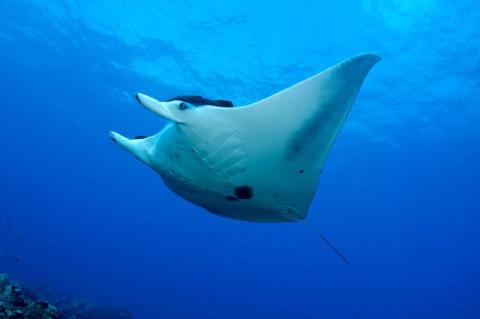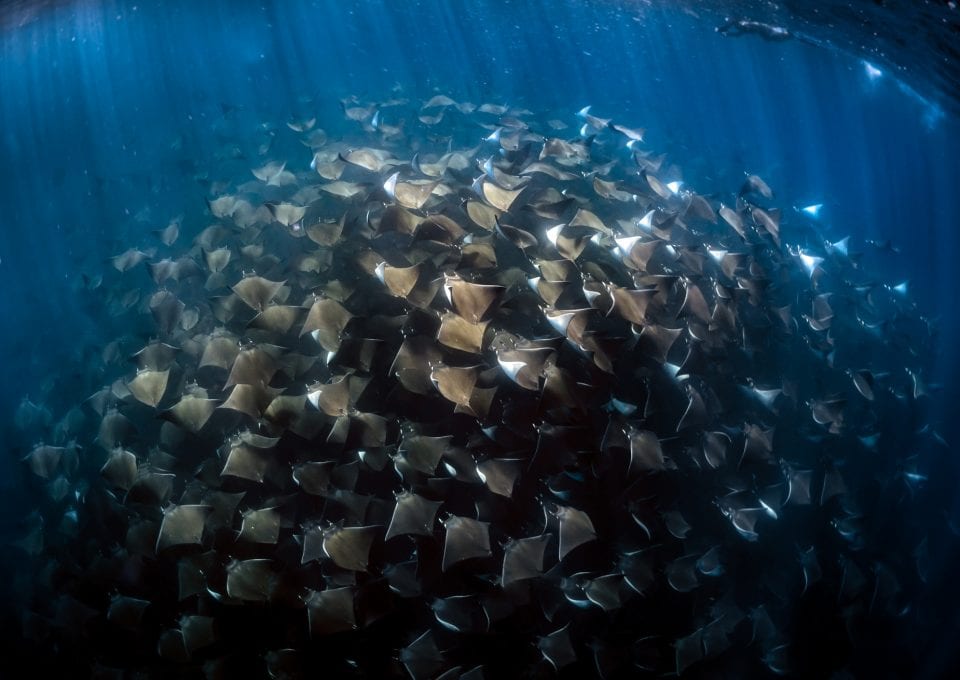
We’re in awe of the charismatic marine megafauna Mobula. These are the manta and devil rays — two manta species and seven devil ray species. All Mobulas have two structures called cephalic lobes which extend out and help to channel water into the mouth for feeding. If you look at the devil rays, these appear to resemble two horns, hence the name devil. ‘Manta’ means blanket or cloak in Spanish which describes the animals’ large, flat, diamond-shaped bodies.
The mobulids, as they are known collectively, are cartilaginous (skeletons are primarily composed of cartilage), like sharks and other rays. The largest – giant manta rays — can reach 23 feet (seven meters) in width and weigh up to two tons. The devil rays are smaller than the manta rays and harder to find. When people can observe them, they’re often in huge aggregations. All live in tropical, subtropical and temperate waters across the globe.
It’s tiny plankton that feed both the giant mantas and the smaller devil rays. They use their cartilaginous gill plates to filter plankton and small fishes from the surface waters. Here you’ll see rays consume plankton, not unlike the behavior of humpback whales. Devil rays gather in the Sea of Cortez to feed and breed, where scientists have studied them extensively.
Love is in the Air
Scientists have observed pygmy devil rays by the thousands gathered during courtship events. Individual rays fling themselves out of the water, and then belly-flop back into the ocean with a crash. More and more join in over time, until the air is filled with leaping rays.
Although researchers can’t be sure exactly what is going on, this breathtaking behavior has been observed in many species of Mobula. During courtship a female releases pheromones, attracting males and “with the males in hot pursuit, the female twists and turns in the water, deking around obstacles and navigating at high speed in an effort to judge her suitors’ physical prowess. To attract more males to choose from, she may breach the surface in acrobatic leaps.”
Watch this video of manta rays.
After a successful mating, the gestation period is about 12 months, when the mobulid mothers give birth to live young. These fish are ovoviviparous: the female retains the egg, which develops inside her body. Once the egg hatches, it remains inside the mother and is nurtured from within. Their reproductive rate is low – at most, only one pup a year—and the females don’t reach reproductive age until 10-15 years. Definitely not as quickly as other marine life. Research into the breeding behavior of mobulids has become increasingly important as more species are threatened by fisheries, pollution and habitat loss.

Threats and Conservation
Mobulids aggregate in large numbers for many reasons including for socializing, feeding, courtship and mating, avoiding predators, cleaning, and thermoregulation. The large numbers of rays in one place makes them more vulnerable to fisheries, bycatch, entanglement in nets, and boat collisions.
Around the world, people fish for mobulids for food, both locally and commercially. And there has been a significant increase in fisheries for them due to the growing consumption of their gill plates for for various reasons including Chinese medicine. This is devastating some populations.
Another major threat is that many species of mobulids are caught in nets targeted for oceanic species like tuna and swordfish. Bycatch describes fish and other marine creatures that are caught unintentionally by fisheries. Bycatch primarily drives population declines in long-lived, slow-reproducing species like the mobulids.
Scientists around the world are conducting research to protect these vulnerable species where basic information is missing. The research includes tagging of individuals in order to understand their movements, and looking at the genes of animals caught in nets to study population dynamics. A lab at the University of California, Santa Cruz is dedicated to using science to discover conservation solutions to bycatch (our Featured Scientists got her PhD in that including testing new types of fishing gear.
Read more about Mobula conservation.
Read more about Mobula behavior.
















